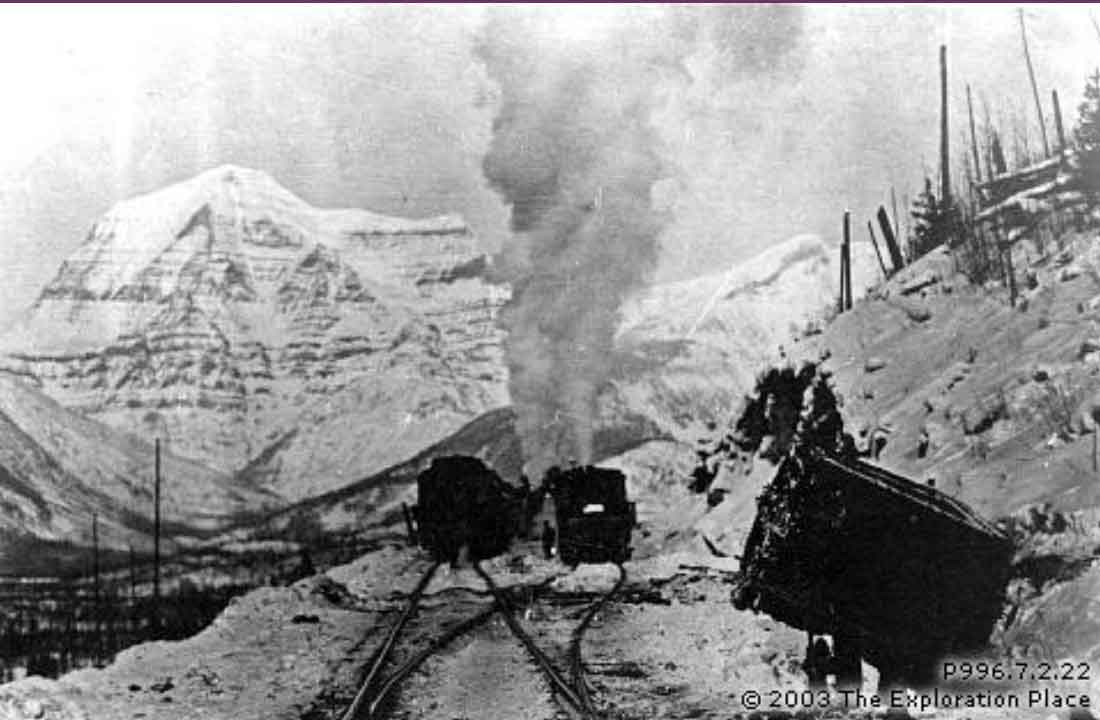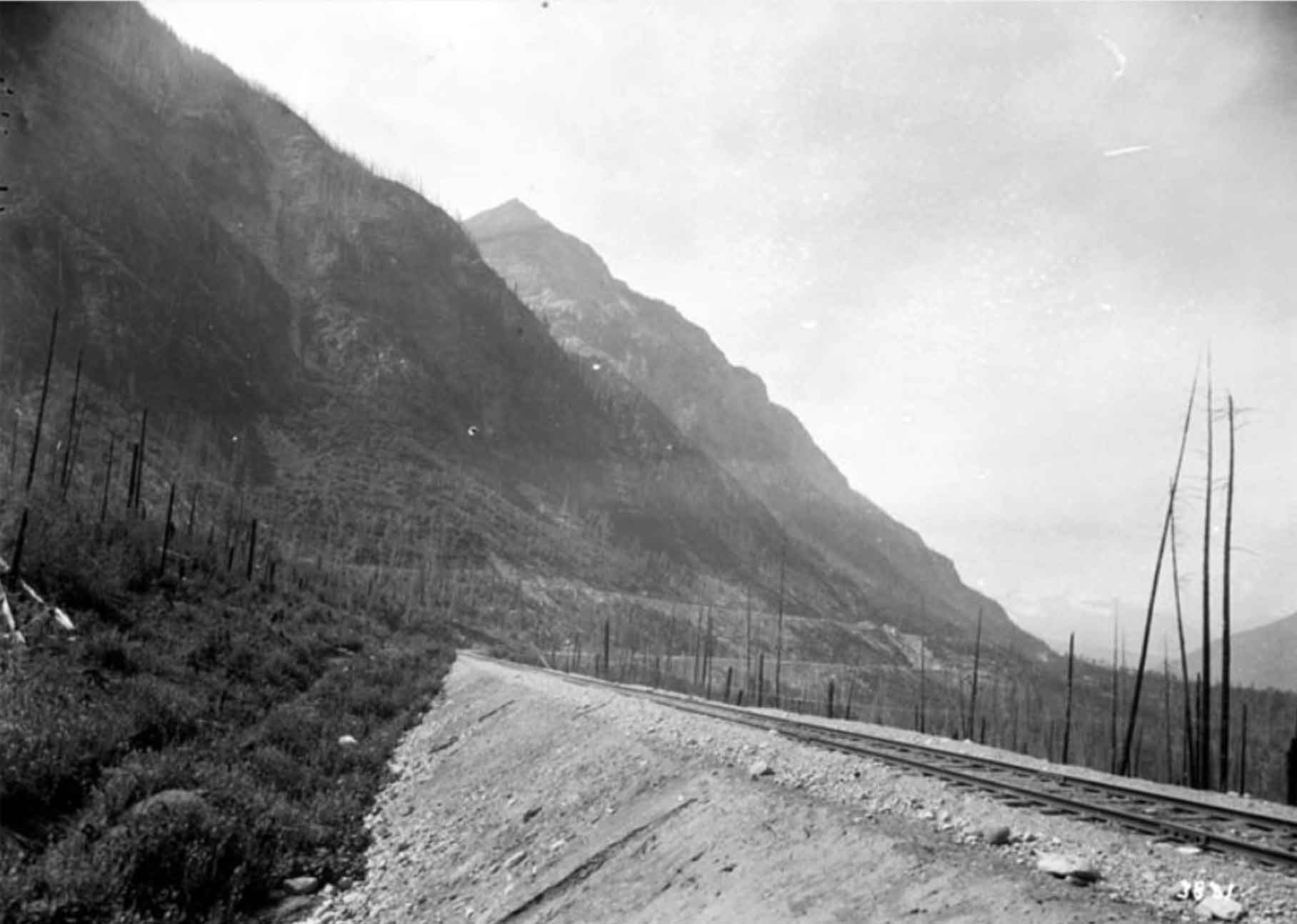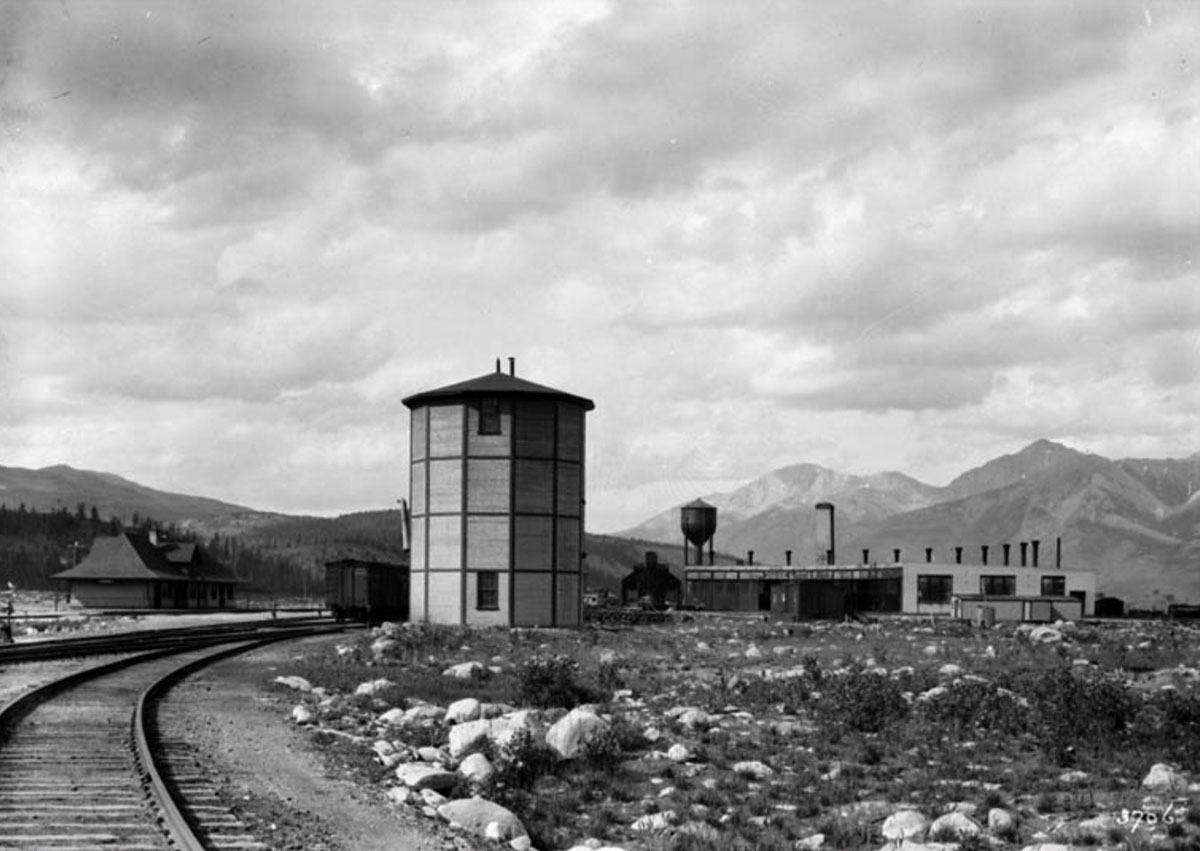
Construction work on the Grand Trunk Pacific Railway line, Smithsonian-A.C.C. Robson expedition, 1911
Whyte Museum of the Canadian Rockies [accessed 14 October 2025]

Train derailment on the main line west near Mile 13 during construction of the Grand Trunk Pacific Railway. Circa 1912
Fraser Fort George Regional Museum [accessed 14 October 2025]

Grand Trunk Pacific track near Mount Robson. Canadian National track above.
Photo: William James Topley, 1914
Library and Archives Canada [accessed 14 October 2025]

Jasper — Grand Trunk Pacific Railway.
Photo: William Topley, 1914
Library and Archives Canada [accessed 14 October 2025]
Grand Trunk Pacific Railway
1914–1919
Largely constructed between 1907 and 1914, the railway operated from 1914 to 1919. Despite poor decision-making by the various levels of government and the railway management, the GTPR established local employment opportunities, a telegraph service, and freight, passenger and mail transportation.
The track of the Canadian Northern Railway through the Canadian Rockies in 1913 roughly paralleled the GTPR line of 1911 and created about 100 miles of duplication. In 1917, a contingent from the Corps of Canadian Railway Troops added several crossovers to amalgamate the tracks into a single line along the preferred grade as far west as Red Pass Junction. The surplus rails were lifted and the heavier grade GTPR ones shipped to France for use during World War I.
In 1915, unable to meet its debts, the GTP asked the federal government to take over the GTPR. The CNoR was in worse financial shape. The royal commission that considered the issue in 1916 released its findings in 1917. In March 1919, after the GTPR has defaulted on construction loans to the federal government, the federal Department of Railways and Canals effectively took control of the GTPR before it was merged into the CNR in July 1920. Noting numerous construction blunders, the 1921 arbitration on worth also ranked its significance within the naïve railway schemes of that era by this observation: It would be difficult to imagine a more misconceived project. The GTP itself was nationalized in 1922.
It has already been described how the importance of the Jasper area as a transcontinental route deteriorated after the decision was made to build the Canadian Pacific Railway through another pass further south. But during the last few years of the nineteenth century, once the Canadian Pacific Railway was constructed, certain businessmen and politicians became convinced of the need for an alternative trans- continental railway line, following a more northerly route across the prairies. The advantages to railroads of the Yellowhead over the other passes through the Rockies were well known, and just after the turn of the century the Grank Trunk Pacific project was begun. However, it was to be another decade before steel reached the new national park which had been established along the right-of-way.
The National Transcontinental Railway Act became law near the end of 1903, representing an agreement between the Ministry of Railways and Canals and the newly incorporated Grand Trunk Pacific Railway Company for the construction of a railway from Moncton, New Brunswick, to the Pacific Coast. The early plans for the western line, developed in 1902, were to follow the route from Edmonton to the coast through the Yellowhead Pass, along the original Sandford Fleming survey.
— Gainer
- — “The Canadian Rockies. Yellowhead Pass Route.” Whyte Museum 02.6 G76 pam (1913)
- — Main Line Between Winnipeg, Edmonton, and Prince George. Table 5 — Tête Jaune to Prince George. 1914
- 1907 GTPR begins construction along Skeena and Bulkley Rivers
- 1919 Federal Government takes over GTP
- 1911 GTP Yellowhead Pass
- 1923 GTP part of CNR
- 1909 Washburn GTP still e of edmonton; YHP
- 1910 Talbot through YHP with GTP party
- 1910 GTP at Wolf Creek
- 1913 GTP as far as TJC
- 1912 GTP to TJC
- 1914 GTP Last Spike
- 1914 First passenger train to Prince George
- 1912 GTP scow arrives Ft George
- 1922 GTPR and Canadian Northern Railway merge to form the Canadian National Railway
- 1908 GTP identifies Reserve 1 as site for station
- Grand Trunk Pacific Railway [1914–1919]. Main Line Between Winnipeg, Edmonton, and Prince George. Table 5 — Tête Jaune to Prince George. 1914
- Lower, Joseph Arthur [1907–]. The Grand Trunk Pacific Railway and British Columbia (thesis). University of British Columbia, 1939. University of British Columbia Library
- Lower, Joseph Arthur [1907–]. “The construction of the Grand Trunk Pacific Railway in British Columbia.” B.C. Historical Quarterly, 4, no. 3 (1940):163-181
- Bohi, Charles W. Canadian National’s Western Depots. The Country Stations in Western Canada. Railfare Enterprises, 1977
- Gainer, Brenda. The human history of Jasper National Park, Alberta. Manuscript report 441. Ottawa: Parks Canada, 1981. Parks Canada [accessed 28 January 2025]

